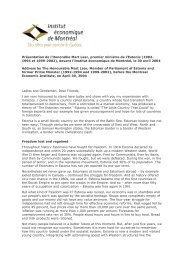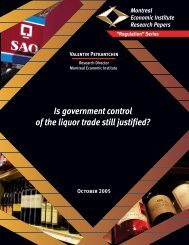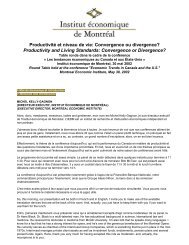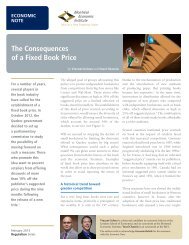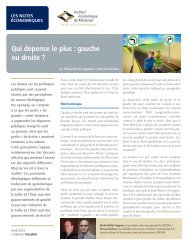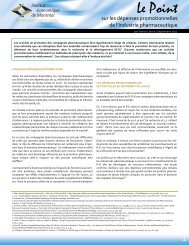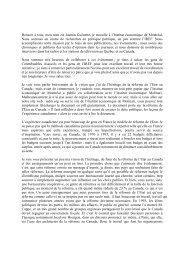Publication (PDF format) - Institut économique de Montréal
Publication (PDF format) - Institut économique de Montréal
Publication (PDF format) - Institut économique de Montréal
Create successful ePaper yourself
Turn your PDF publications into a flip-book with our unique Google optimized e-Paper software.
Why New International Taxes for Development Are InefficientChart 4Qualitative Evaluation of Current or Proposed IFD Taxes Using Standard Criteria for Good TaxesSolidarity Levyon AirlineTicketsFinancialTransactionTaxes (FTTs)CarbonTaxesSolidarityTobaccoContributionSDRAllocationsEfficiencygenerally poorGillen et al. (2002),probably poorMatheson (2011)averageIMF (2011)probably poorSee references in textprobably poorCooper (2011)IMF (2011)The Economist (2013b)Coto-Millán et al.as discussed(2005)in textAdministrativecostslow to averageCour <strong>de</strong>s comptesaverage to highBronolo (2011)average to highIMF (2011)probably highlow(2010)FlexibilitypoorpoorpoorpooruncertainPoliticalresponsibility(accountability)mostly poormostly poormostly poormostly poorpoorFairness and taxinci<strong>de</strong>ncegoodCour <strong>de</strong>s comptes(2010)probably poor inthe long runMatheson (2011)poor exceptwith elaboratecompensationarrangementspoorprobably poorIMF (2011)Source: See text. The criteria are borrowed from Stiglitz (1988), pp. 385-410.2.2 EfficiencyFirst, let us apply the efficiency criteria. A taxcan be called efficient if its excess bur<strong>de</strong>n is as smallas possible for the required revenues to be raised. Wecan measure the extent of the excess bur<strong>de</strong>n if weknow the price elasticity of <strong>de</strong>mandfor the good orservice in question. 50 Here, we need to un<strong>de</strong>rstandthat, other things being equal, the lower the priceelasticity of <strong>de</strong>mand of a good, the smaller will bethe excess bur<strong>de</strong>n imposed by a tax on this good.Price elasticity of <strong>de</strong>mand, or “price elasticity”for short, is a technical concept that <strong>de</strong>scribesresponsiveness to price changes. Demand is more50. For a technical discussion of elasticities, see IMF (2011), pp. 23-26. Other elasticities are used in scientific literature, such as supplyelasticity.elastic if quantity <strong>de</strong>man<strong>de</strong>d changes more inresponse to price changes; it is less elastic (or moreinelastic) if quantity <strong>de</strong>man<strong>de</strong>d is less sensitive toprice changes. If, for example, a price increase of10% brings a 15% drop in quantity <strong>de</strong>man<strong>de</strong>d, wesay that the elasticity of <strong>de</strong>mand is 1.5—for theproportional change in quantity <strong>de</strong>man<strong>de</strong>d is oneand a half times the change in price. To take anotherexample, if the resulting drop in quantity <strong>de</strong>man<strong>de</strong>dis only 3%, the elasticity of <strong>de</strong>mand would be 0.3—for the proportional change in quantity <strong>de</strong>man<strong>de</strong>dis 30% of the change in price. 51 The convention is51. Technically, the coefficient of elasticity has a negative sign, for there isan inverse relation between a price change and the resulting change inquantity <strong>de</strong>man<strong>de</strong>d. Properly speaking, then, the coefficients we usedas examples should be written as -1.5 and -0.3. We will neglect thenegative signs for purposes of simplicity. (They will appear in Chart 6,though, which is reproduced from an econometric evaluation.)Montreal Economic <strong>Institut</strong>e 17



